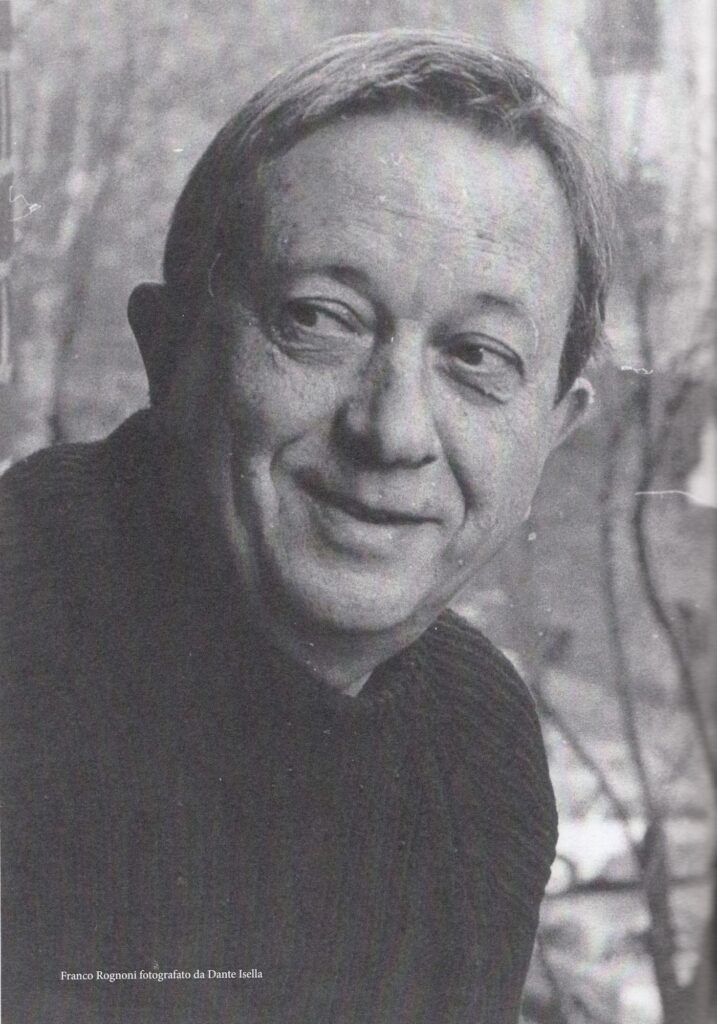Franco Rognoni

SHORT BIOGRAPHY
Franco Rognoni was born in Milan on 20 September 1913 to Giuseppe and Giuseppina Carabelli in a petit-bourgeois family. At a very young age, he began to take an interest in drawing and painting and, as an adolescent, he attended the technical school of weaving and then the Higher School of Applied Art at Castello Sforzesco.
The critic Raffaello Giolli was his first supporter, an important cultural reference that allowed Rognoni to open up new horizons. As early as 1934, he worked as a draughtsman for important magazines and newspapers while in ’38 he exhibited for the first time. His training was influenced by artists such as Sironi, de Pisis and Modigliani, while his passion for books brought him closer to the graphic and pictorial solutions of German Expressionism.
Luino, on Lake Maggiore, welcomed him during the war and here he concentrated on his production (which was enriched with engravings and illustrations), thus maintaining an important collaboration with many periodicals and fundamental contacts with publishers and collectors.
After the First World War, he returned to Milan and in 1946 married Mariuccia Noè, with whom he shared significant cultural interests for the rest of his life. New drawings and paintings were created in the Lambrate studio, developing the artist’s fundamental themes and expressing a highly personal anti-academic language.
RAI proposed him a project as a set designer-costume designer and the same activity was carried out for the Piccola Scala and La Fenice in Venice.
Between the 1970s and 1980s, his attention shifted to the human figure, seen with critical and sceptical connotations, and the city, increasingly represented as an alienating context. Alongside this connotation appears a dreamy aspect, linked to memory. The lake, another privileged place of his representation and his existence alternating between Milan and Luino, enhances this pictorial dimension that fixes protagonists suspended between reality and imagination.
The last decade, the 1990s, saw the artist committed to the representation of vitality. Ample space is therefore dedicated to colour, in a pictorial direction that becomes increasingly Central European, in the sign of Symbolism and Expressionism.
The artist passed away in Milan on 11 March 1999.
Few 20th century artists knew how to be as ‘inside’ their time as Franco Rognoni and few artists, moreover, knew how to be so ‘beyond’ their seasons. His is in fact a figure of great depth: a cultured artist, open to the visions of the European masters, he knew how to be so far above the situations that surrounded him that he was able to give his painting an aura of a-temporality and, consequently, a perfect adherence even to our times.
Rognoni is an eclectic lyricist, a poet of the brush, able to anticipate the times with his intuitions. His style is unique and unmistakable, incorporating dozens of references that bear first and foremost the names of artists such as Licini, Soldati and Sironi.
It would not be possible to get to know Rognoni in depth without considering these cornerstones, without assessing his being beyond fashions and currents, which is probably also why his painting is still surprisingly modern.
Moreover, he himself was well aware of this when he stated as early as 1942: ‘I understand art as an expression not only of an aesthetic end in itself, but also, and above all, of an inner ethic. Only in this way do I believe that the work does not die with the changing aesthetic taste.”
Rognoni’s universe is animated by immediately recognisable subjects: Venice enchanted in its reflections, suburbs, cities teeming with passers-by, commuters, bankers, entrepreneurs, dancers, musicians, still lifes, gondolas and trams.
In his evocation of reality, Rognoni plays on different planes of representation. The cycle of Interni/Esterni (Interiors/Exteriors) bears witness to this: the city is depicted simultaneously inside the house and outside, in the street, as if the observer were omnipresent and had the possibility of scrutinising every happening.
Rognoni reveals himself with a clear, scratching, free sign and a skilful chromatic layout.
Colour is another fundamental component in Rognoni’s works; where the figure dissolves and distorts, colour emerges vibrant and charged with a lyrical aesthetic that touches the chords of the soul.
